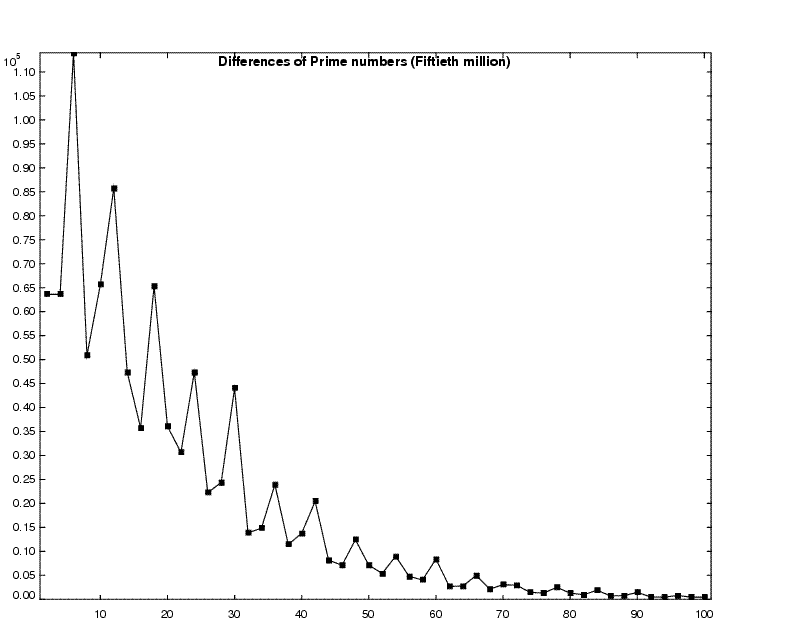Distribution of Primes
(O. Shanker)
A statistical analysis of the gaps between prime numbers has shown
an exciting result.
The correlations between neighbouring primes have been studied
extensively (see Jumping champions and links from Andrew Granville's page, for example).
We report here some further correlations, and a heuristic explanation (see also Correlations in Prime Number Distribution and L-function Zeros).
The distribution for the differences of the prime numbers is shown
in the figure below for the fiftieth million set of primes.

The horizontal axis shows the gap between consecutive primes,
and the vertical axis shows the count for the number of times the
difference occurs in the fiftieth million set of primes.
The structure in the histogram is interesting, e.g., the peaks when the
differences are multiples of 6. When a prime number is divided by 6,
the remainder is either 1 or 5. An analysis of the peaks
has shown evidence for a correlation between
the probability of the remainder being 1 or 5 and the
remainder for the previous prime number. The table below shows the
correlation when the fiftieth million set of zeros is analysed.
The first row shows the probabilities for a prime number
with remainder 1 being followed by a prime number with remainder 1
or remainder 5 respectively. The second row
shows the probabilities for a prime number
with remainder 5 being followed by a prime number with remainder 1
or remainder 5 respectively. The dependence on the previous prime
number is clear from the differences in the table entries. We see
that the ratio of the number of neighbouring primes with the same remainder
to the number of neighbouring primes with different remainders is 0.811.
| Fiftieth million primes, Divisor 6 |
| Remainder | 1 | 5 |
| 1 | 0.224 | 0.276 |
| 5 | 0.276 | 0.224 |
One can give a heuristic argument for the correlation.
All primes will be of the type 6*k+1 or 6*k+5. These two
arithmetic progressions are interlaced. We know
that the density of primes at N is of order 1/ln(N).
Let us consider a heuristic model, i.e., each term in either of the arithmetic
progressions has a "probability" 3/ln(N) of being prime.
The heuristic model predicts that the
the ratio of the number of neighbouring prime pairs with the same
remainders to the number of neighbouring prime pairs with different
remainders is (1-3/ln(N)),
which numerically is 0.85, almost the observed value.
While the heuristic model is quite interesting,
it is not a rigorous proof for the correlation.
Further, it cannot be the complete story,
since it predicts that a gap of 6 will
be the most likely gap, while the work on
jumping champions
(an integer D is
called a jumping champion if D is the most frequently
occurring difference between
consecutive primes <= x for some x ) shows that
for very large numbers the most
likely gap will be a primorial larger than 6.
Thus, the correlation reported here and
the heuristic explanation point to areas that
ought to be investigated further.
We can also see the effect when we consider the remainder when a
prime number is divided by 4. The remainder can be 1 or 3.
The table below again shows the
correlation when the fiftieth million set of zeros is analysed.
The first row shows the probabilities for a prime number
with remainder 1 being followed by a prime number with remainder 1
or remainder 3 respectively. The second row
shows the probabilities for a prime number
with remainder 3 being followed by a prime number with remainder 1
or remainder 3 respectively. The dependence on the previous prime
number is clear from the differences in the table entries.
| Fiftieth million primes, Divisor 4 |
| Remainder | 1 | 3 |
| 1 | 0.226 | 0.274 |
| 3 | 0.274 | 0.226 |
Shown below are the tables from a similar analysis of the tenth
million primes.
| Tenth million primes, Divisor 6 |
| Remainder | 1 | 5 |
| 1 | 0.222 | 0.278 |
| 5 | 0.278 | 0.222 |
| Tenth million primes, Divisor 4 |
| Remainder | 1 | 3 |
| 1 | 0.224 | 0.276 |
| 3 | 0.276 | 0.224 |
Here is a link giving interesting information
about prime numbers.
The distribution of zeros of the Riemann zeta function are related
to the distribution of primes. Here is a link to some work
on the zeros of the Riemann zeta function.
Here are links to: my home page, and O. Shanker publication list.
O. Shanker Email: oshanker.AT.gmail.com

